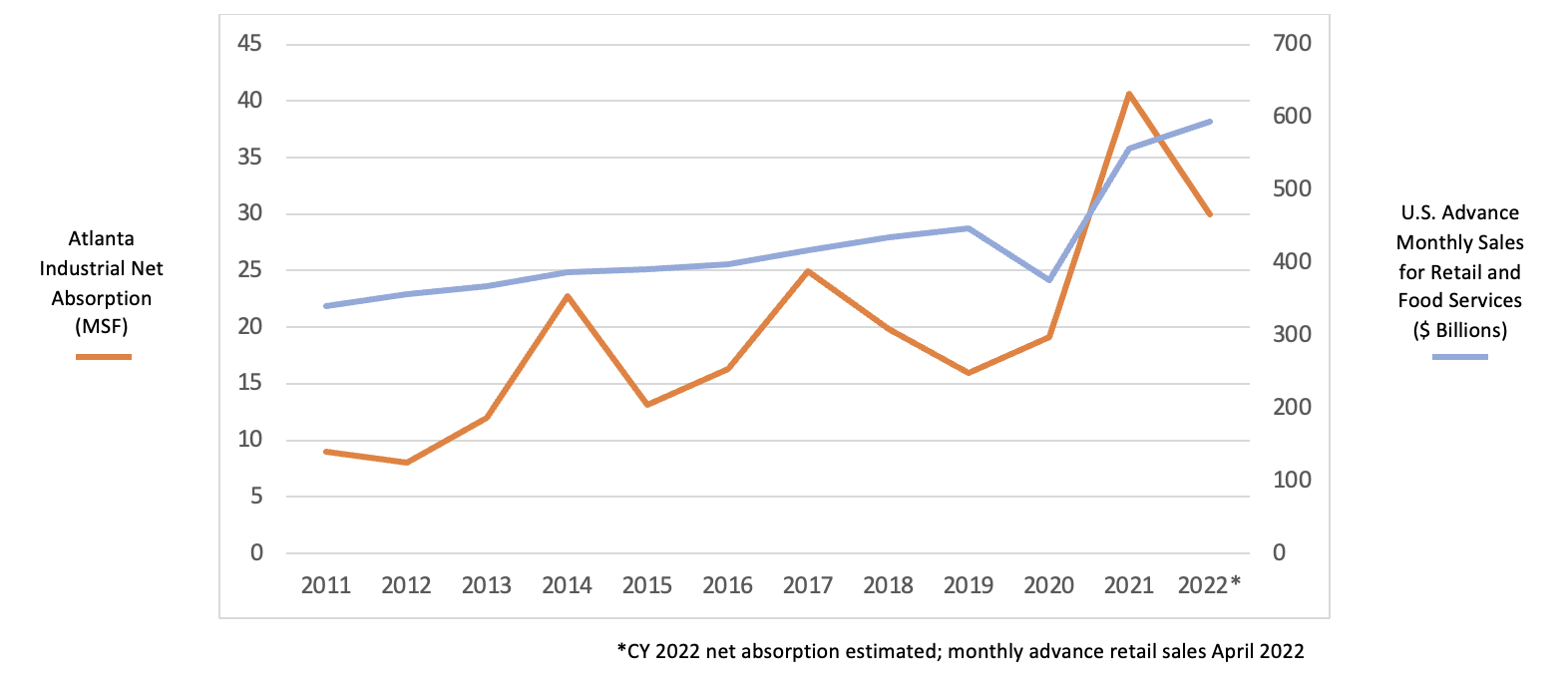MARKET BRIEF: INFLATION, SUPPLY, & LABOR CONSTRAINTS WON’T DERAIL INDUSTRIAL EXPANSION

WHAT YOU NEED TO KNOW
- Demand for industrial space remains at unprecedented levels
- Inflation and supply chain challenges are short-term headwinds to growth
- The economy overall is expected to cool, but GDP to remain positive in 2022 (2.3%) and 2023 (2.1%)
- Durable structural trends such as in-migration and retail spending will drive continued industrial growth
It’s no secret demand for Atlanta Industrial space has reached record highs, recently peaking at more than 40 million sq. ft. absorbed over the last year. This level of demand is roughly equivalent to what would normally be absorbed over the course of 3.5 years given current cycle performance, and has ushered in unprecedented levels of new development activity and new capital.
But inflation concerns, supply chain challenges and declines in worker productivity are making headlines, raising concerns over whether an economic slowdown is approaching. The most recent inflation measures in March and April reflected increases of 8.5% and 8.3%, respectively, eating into manufacturers’ margins and ushering in the likelihood of pass-through costs to businesses and consumers. Supply chain disruption also continues to drag on the economy. A recent manufacturers survey conducted by PwC revealed a majority (58%) of U.S. manufacturers identified supply chain resilience as “very important to their ability to grow” in 2022.

Countering these headwinds is the U.S. consumer, continuing to anchor support for the economy. Spending on retail and food services from February through April was up 10.8% from one year ago, an indication that rising inflation isn’t eroding the confidence of consumers. Additionally, business investment rose by 9.2 percent in Q1. Looking ahead, Congressional Budget Office estimates place inflation below 5% by Q4 of this year, potentially easing pricing pressures for both businesses and consumers. While cyclical pressures of inflation and supply chain challenges make headlines, long-term structural factors have far greater impact on sustained demand for Atlanta area industrial facilities. For example,
- Retail sales have demonstrated long-run growth (300%+) from 1992-2022 and correlate closely with industrial absorption trends (see Figure), demonstrating the close relationship between consumer spending and demand for manufacturing, storage and distribution facilities.
- Metro Atlanta serves as the regional distribution hub for the Southeastern U.S., the fastest growing region of the country (Georgia’s population alone grew by 10.6% from 2010-2020). This decades-long trend of consumer base expansion provides additional insulation from economic disruption.
- For more than 20 years, Atlanta has ranked as the lowest-cost large industrial market for occupiers in the nation (among the top 10 largest markets). This lower relative cost, while providing access to 80% of U.S. consumers within a two-day drive offers users compelling location operational advantages.
The Conference Board’s spring economic forecast calls for positive but slower GDP growth in 2022 of 2.3%, followed by 2.1% in 2023. While pricing for goods and services will likely remain elevated due to cyclical pressures such as wage growth, supply chain disruptions and upward pressure on interest rates, a recession is not in the Conference Board’s forecast.
